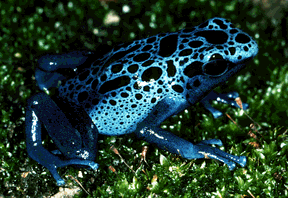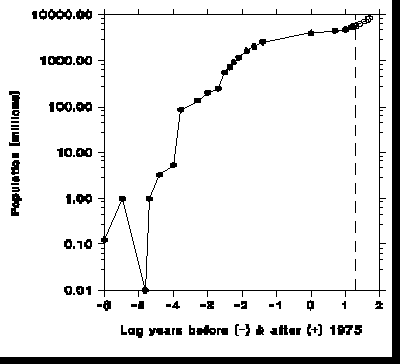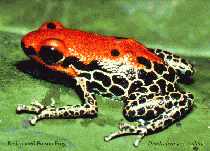

By Gary W. Harding, Research Scientist

In recent years, some prominent economists have argued that there is no upper limit to human population growth, that finiteness in resources is meaningless, and that prosperity can be had by all. Biologists have predicted for decades that a population crash is inevitable a few generations after the ecosystem's carrying capacity for humans is exceeded (1). Some believe that we may have already exceeded it. Although this carrying capacity is unknown, it is undeniable that non-renewable resources will eventually be used up; that renewable resources have been and will continue to be plundered until they no longer exist; that pollution will take its toll; and that population growth cannot reach a state where there is a mass of humans expanding out from Earth at the speed of light.
Economists verses Biologists
Economists point to past dire predictions from the biologists that didn't come true to justify their position. Eventually, they say, "market forces" will determine how big the population gets. We have run out of resources in the past and have always found something else to replace them. However, economists ignore the quality of life issue; biologists usually discuss this topic in terms of significant diminution.
We live in a complex world, both economically and biologically; too complex to comprehend with our current knowledge. Neither economists nor biologists understand it. Thus, both the economist's belief in perpetual growth and the biologist's predictions of doom lack credibility.
We Live in a World Determined by Human Need
Having appeared on the scene, homo sapiens is as much a part of the natural processes of nature as any other animal. Compared to most, the species has been remarkably successful. Recent economic systems have played a significant roll in this success. At the same time, unanticipated interactions among the members of the ever increasing human population make economic predictions unreliable. However, without getting embroiled in controversy about details, there are some general economic principles that we do understand.
Economics is Driven by Short-Term Self Interest
Humans are torn between self interests and group interests. If we define the ultimate group interests as those of society as a whole, then there is clearly a conflict between the two. The focus of this conflict rests with the pursuit of short-term personal gain, which is opposed by the requirement for long-term group survival. The net balance between these two factors determines the nature of economic (and political) systems.
Current economic systems provide a basis for many more humans to live than could possibly be supported in a subsistence way of life. That is, current population levels depend upon non-renewable, as well as renewable, resources for their existence. However, these systems also provide an opportunity for a few individuals to pursue self interest at the expense of the many. To avoid anarchy and subsequent collapse, society lays down both personal and economic rules for acceptable conduct. Over time, these rules change as the acquisition of wealth and power by the few feeds upon itself. The many pay the price not only economically and socially, but environmentally as well.
We all understand the concept behind the laws of supply and demand. Most have failed to notice, however, that recent economic innovations have repealed these laws. Supply, demand and price can be economically manipulated in the short term, with no concern about the long term consequences (e.g. chromium). Increased demand can be artificially created by economic forces which appeal to the population's short-term interests (e.g. advertising). Resources which are in fact scarce, particularly considering long-term need, can be made to appear abundant (e.g. oil), at least in the short term.
The "short" in short-term is getting shorter. Among the population, instant gratification is the rule of the day. Easy credit has played a significant role in the dominance of this attitude in some societies. Thus, "buy now - pay later" has contributed to a substantial decline in societal group interests. The result has been a proliferation of subgroups, each competing with the others to satisfy its own self interests. As the number of these subgroups increases even more rapidly than the population, the societal group becomes paralyzed as it attempts to solve its problems.
We Live in a Biological World
It is true that humans are animals and therefore, subject to the laws of nature like any other animal. These laws involve intertwining of uncountable closed-loop feedback systems. If we mess with one, unexpected feedback consequences pop up in others. Without getting embroiled in controversy about details, however, there are some general biological principles that we do understand.
Mass Extinction and Evolution
Mass extinctions, in which from 40% to 95% of all plant and animal species died out, have occurred several times in the distant past. One occurred about 225 million years ago which ushered in the age of reptiles. Another, about 65 million years ago, spelled the end of reptile dominance and led to the age of mammals. The cause of these past events is hotly debated, but the proposed explanations all have geologic (volcanoes), cosmic (asteroids), climatic (hot verses cold), and pathogenic (diseases) bases.
Following each mass extinction, there was a rapid radiation of new species. Once in existence, most species remained relatively unchanged for millions of years until they, in turn, scummed to extinction. Other species were molded, in a Darwinian sense, by adaptation to minor fluctuations in the ecosystem. Some animals, like the horse, also got much bigger.
Extinction does not require that every member of a species disappear within a short period of time. All that is needed is a decline to a level where population maintenance is no longer viable. Such a species may hang on for thousands of years on the road to extinction.
What is different about the current rash of extinctions is that its cause is the massive and widespread impact on the ecosystem of a single animal. The generation of new species requires enough time for adaptation to take place. The rate of ecosystem change is now so rapid that the species which might otherwise have survived a mass extinction may not be able to adapt to the new world.
In nature, the rule for survival of species (in warm climates) has always been "small is good - big is bad". The opposite holds true only in very cold environments, where larger animals fare better. Small animals are the ones that survive mass extinctions; big ones generally do not. There were never very many of the largest animals that ever lived (some dinosaurs, elephants, rhinoceroses and whales) and those who made a living as predators were indeed rare. At various times in the past, vast herds of large herbivores roamed the savannas of Africa and the plains of North America. However, 80 million wildebeest and 60 million bison don't even come close to the vast number of humans.
Human Population
An astonishing fact was reported in the news recently. "With the possible exception of the rat, humans are now the most numerous mammal on earth"! Few have recognized the significance of this statement. Something like this has never happened in the nearly 600 million year history of life on our planet. The population of a large animal has never before reached such dominance in the ecosystem.
How did human population manage to grow so large in spite of the natural forces against large animals that should have prevented it? One can point to the development of his large brain and erect posture which freed his hands. But, there is more to it than that. At the end of a severe ice age, about 65,000 years ago, it has been argued that there were only about 10,000 individuals who managed to make it through the tough times. By 50,000 years ago, as a result of good climates and fortuitous migrations, the survivors had precipitated population mini-explosions all around the planet (2).
Population Growth Surges
 Many of us have seen graphs of human
population growth with its enormous acceleration in the last 200 years. However,
if one plots human population on a log-log scale, it is apparent that this population
growth occurred in three surges (3). The first coincided with the use of tools,
fire and the cultural revolution that homo sapiens brought through the ice ages.
The second occurred with the agricultural revolution about 10,000 years ago.
The last matches the rise of the industrial (and medical) revolution a mere
200 years ago. It is the latter which has produced the enormous spurt we have
recently experienced. The most significant aspect of this graph is that the
time between surges has shortened dramatically. If past behavior is the best
predictor of future behavior, we are soon due for another surge.
Many of us have seen graphs of human
population growth with its enormous acceleration in the last 200 years. However,
if one plots human population on a log-log scale, it is apparent that this population
growth occurred in three surges (3). The first coincided with the use of tools,
fire and the cultural revolution that homo sapiens brought through the ice ages.
The second occurred with the agricultural revolution about 10,000 years ago.
The last matches the rise of the industrial (and medical) revolution a mere
200 years ago. It is the latter which has produced the enormous spurt we have
recently experienced. The most significant aspect of this graph is that the
time between surges has shortened dramatically. If past behavior is the best
predictor of future behavior, we are soon due for another surge.
The relation between innovation and population growth is embedded in the log-log population graph. There was rapid growth at the start of each surge. Then, growth rate slowed as people adapted to the precipitating innovations. Each surge increased the population more than 10 fold. We may be nearing the end of the present surge; growth rates are starting to decline. After the initial spurt, subsequent innovations did not maintained the growth rate. The only significant innovations were those that produced the next surge. Surge subsequent innovations may have played a role in the decline of population growth rate as the surge came to a close. If those innovations enhanced overall standards of living and longevity for some, average family size may have gone down. An example would be the demographic transition during the present surge as some countries have industrialized and applied medical technology. However, most innovations have not reach a majority of the population. If they had, they might have been significant enough to precipitate another surge.
The activities of 5.6 billion humans, with many more to come, portend ominous consequences for the future of life as we know it. Already, there has been a significant increase in green-house gases, particularly carbon dioxide associated with fossil fuel burning. The predicted impacts of global warming upon climate, if true, are very disturbing. If the ozone layer is really being depleted (recent measurements do not reflect a natural fluctuation), the detrimental impact of increased ultraviolet light on plants and animals could be devastating. Potable water is hard to come by and getting harder. Plants and animals are becoming extinct at an alarming rate. It is this last item that may forebode the worst consequences for humans.
Frogs are Dying

All around the Earth, populations of most species of frogs and toads are declining. Not only are the adults dying, but a majority of their eggs are not hatching and most of the few hatched polliwogs are dying as well. A number of species of frogs and toads have already become extinct; more than would be expected at previous rates of species loss over the past few centuries. Meanwhile, a very few species of frogs and toads are thriving. Scientists are scrambling to find the reasons why.
WHO CARES!!, you say. We all should! This is why. The frog is the "miner's canary" for our environment. Frogs and toads have passed through numerous mass extinctions for nearly 300 million years. What has made them such robust survivors is their remarkable skin. It is permeable to water and air borne substances such as oxygen. Frog skin is a complex chemical factory as well. It produces a protective coating to prevent desiccation. The skin of several species of frogs and toads produces potent antibiotics and predator repelling toxins.
Frog skin is vulnerable to ultraviolet light. Frogs may, therefore, be the first casualty of ozone-layer depletion. Because its skin is so permeable, the frog is also sensitive to air, water, and soil pollutants. Dying frogs may indicate that the worldwide concentration of pollutants has reached a lethal level for them. If frogs go, can we be far behind?
Can the Merry-Go-Round Go Round and Round
What will be the basis for another human population growth surge? One can think of several possibilities including: a global economy, an information revolution, and an energy revolution. Whatever it is, it must have a major impact upon survival and reproductive success. A significant element in past surges has been innovations in energy use (fire, beasts of burden, fossil fuels). Thus, the development of an abundant and inexpensive energy source would have a profound effect. On the other hand, could the ecosystem survive such a development and the consequential surge in the number of humans?
Mother Nature May Have a Nasty Surprise in Store for Us
Biologists have long argued that the human population would eventually have to decline, due to significant increases in the death rate. In addition to mass starvation, they predicted that a lethal pathogen could evolve and be spread around the world in a matter of hours through our transportation system. What they had in mind was something like a killer-flu. What occurred was even worse than they could possibly have imagined - a virus which is close to 100% fatal, takes ten years to kill it's victims, and has that much time to be transmitted to new hosts in every corner of the Earth as well as evolve new forms. An effective vaccine is 5-10 years away, if it can be produced at all.
Evidence is now accumulating that, among vertebrates, male fertility is declining. This could be part of the reason for the loss of frogs. Sperm counts have dropped to nearly zero in some populations of alligators and, in a few areas, as many as 20% of human males are functionally sterile. In alligators, a likely cause has been found and the same problem has been verified in humans. It turns out that some of the chemicals released into the environment by humans are estrogen-like when ingested or absorbed into the body. A small excess of estrogen in males, significantly reduces sperm counts and this is extremely difficult to counteract.
Consider the implications of this phenomenon. At the very least, mother nature has provided a self-limiting mechanism for the human population by not only increasing the death rate, but also by ultimately decreasing the birth rate. At the very worst, if nearly all human males become sterile due to self-generated environmental pollution, we could be on the road to extinction in short order. After all, the ultimate cause of extinction for any species is: failure to reproduce. Hopefully, the irony here will not escape us.
1 "The Population Question Revisited", George Moffet, Wilson Quarterly, Vol. 28, Summer 1994, pgs. 54-79.
2 "Pleistocene Population Explosions", Ann Gibbons, Science, Vol. 262, 1 October 1963, pgs. 27-28.
3 "The Human Population", Edward S. Deevey, Jr., Scientific American, Vol. 203, September 1960, pgs. 195-204.